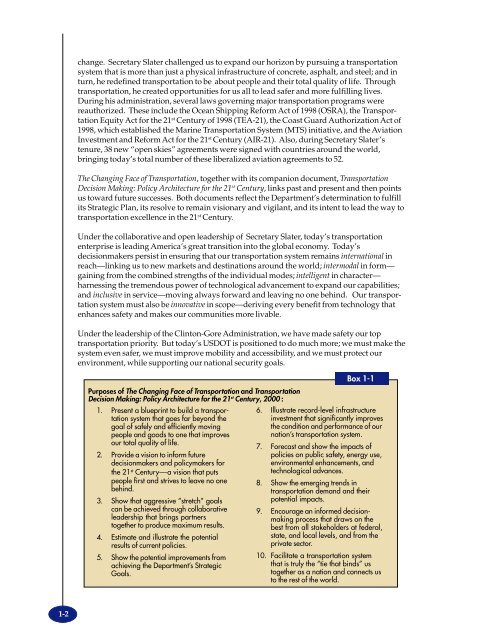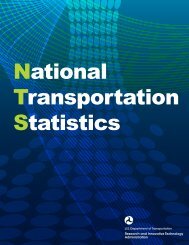TRANSPORTATION - BTS - Bureau of Transportation Statistics
TRANSPORTATION - BTS - Bureau of Transportation Statistics
TRANSPORTATION - BTS - Bureau of Transportation Statistics
You also want an ePaper? Increase the reach of your titles
YUMPU automatically turns print PDFs into web optimized ePapers that Google loves.
change. Secretary Slater challenged us to expand our horizon by pursuing a transportationsystem that is more than just a physical infrastructure <strong>of</strong> concrete, asphalt, and steel; and inturn, he redefined transportation to be about people and their total quality <strong>of</strong> life. Throughtransportation, he created opportunities for us all to lead safer and more fulfilling lives.During his administration, several laws governing major transportation programs werereauthorized. These include the Ocean Shipping Reform Act <strong>of</strong> 1998 (OSRA), the <strong>Transportation</strong>Equity Act for the 21 st Century <strong>of</strong> 1998 (TEA-21), the Coast Guard Authorization Act <strong>of</strong>1998, which established the Marine <strong>Transportation</strong> System (MTS) initiative, and the AviationInvestment and Reform Act for the 21 st Century (AIR-21). Also, during Secretary Slater’stenure, 38 new “open skies” agreements were signed with countries around the world,bringing today’s total number <strong>of</strong> these liberalized aviation agreements to 52.The Changing Face <strong>of</strong> <strong>Transportation</strong>, together with its companion document, <strong>Transportation</strong>Decision Making: Policy Architecture for the 21 st Century, links past and present and then pointsus toward future successes. Both documents reflect the Department’s determination to fulfillits Strategic Plan, its resolve to remain visionary and vigilant, and its intent to lead the way totransportation excellence in the 21 st Century.Under the collaborative and open leadership <strong>of</strong> Secretary Slater, today’s transportationenterprise is leading America’s great transition into the global economy. Today’sdecisionmakers persist in ensuring that our transportation system remains international inreach—linking us to new markets and destinations around the world; intermodal in form—gaining from the combined strengths <strong>of</strong> the individual modes; intelligent in character—harnessing the tremendous power <strong>of</strong> technological advancement to expand our capabilities;and inclusive in service—moving always forward and leaving no one behind. Our transportationsystem must also be innovative in scope—deriving every benefit from technology thatenhances safety and makes our communities more livable.Under the leadership <strong>of</strong> the Clinton-Gore Administration, we have made safety our toptransportation priority. But today’s USDOT is positioned to do much more; we must make thesystem even safer, we must improve mobility and accessibility, and we must protect ourenvironment, while supporting our national security goals.Purposes <strong>of</strong> The Changing Face <strong>of</strong> <strong>Transportation</strong> and <strong>Transportation</strong>Decision Making: Policy Architecture for the 21 st Century, 2000 :1. Present a blueprint to build a transportationsystem that goes far beyond thegoal <strong>of</strong> safely and efficiently movingpeople and goods to one that improvesour total quality <strong>of</strong> life.2. Provide a vision to inform futuredecisionmakers and policymakers forthe 21 st Century—a vision that putspeople first and strives to leave no onebehind.3. Show that aggressive “stretch” goalscan be achieved through collaborativeleadership that brings partnerstogether to produce maximum results.4. Estimate and illustrate the potentialresults <strong>of</strong> current policies.5. Show the potential improvements fromachieving the Department’s StrategicGoals.Box 1-16. Illustrate record-level infrastructureinvestment that significantly improvesthe condition and performance <strong>of</strong> ournation’s transportation system.7. Forecast and show the impacts <strong>of</strong>policies on public safety, energy use,environmental enhancements, andtechnological advances.8. Show the emerging trends intransportation demand and theirpotential impacts.9. Encourage an informed decisionmakingprocess that draws on thebest from all stakeholders at federal,state, and local levels, and from theprivate sector.10. Facilitate a transportation systemthat is truly the “tie that binds” ustogether as a nation and connects usto the rest <strong>of</strong> the world.1-2
















